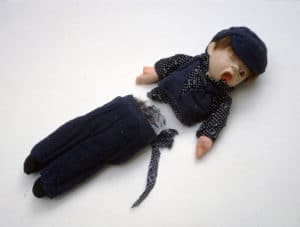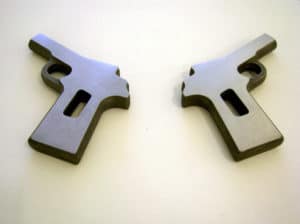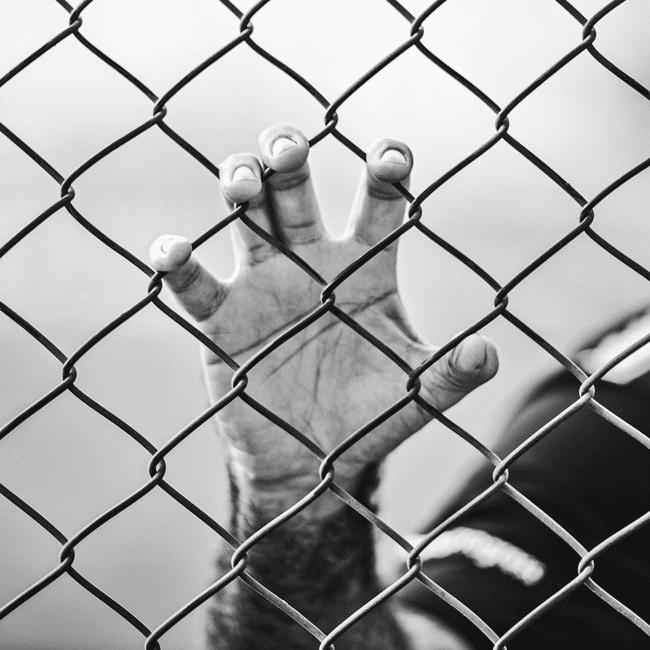
Violence and technology: a shared fate
Opinion + AnalysisRelationshipsSociety + Culture
BY The Ethics Centre 17 DEC 2019
Don’t be distracted by the exploding sheds, steamrolled silverware and factory pressed field of poppies.
Many of the best works in Cornelia Parker’s exhibition at the Museum of Contemporary Art (MCA) are small and unassuming. They are the quiet pieces that ask us to contemplate the nature of the technology we use in acts of violence.
A small pile of dust, some short leads of wire, a child’s doll split in two. These found object artworks – sculptures, just not those carved into marble or clay – are less about the state you see them in, but the journey they have taken.
On closer inspection (and with a little gallery guidance) we find intentional transformations of objects often associated with brutal violence: a gun, its bullets, the blade of a guillotine.
But don’t be alarmed. There is a dark sense of humour at play here. The disemboweled doll, a ginger-haired child in his newsboy cap and overalls, has a cartoon quality to his expression that echoes less of screams of pain than the shock of a bee sting. The boy has been severed at the waist by a guillotine. The very same guillotine that beheaded the infamous Queen of France, Marie Antoinette.
We understand a guillotine as a tool of violence and power, designed to distribute French revolutionary justice at speed to behead the head of state. Here Parker has used the same tool that once transformed European history, to split a stuffed toy of Oliver Twist. Its title suggests a shared fate, that this piece of technology link the iconic Dickensian poor boy and the poster woman for opulence.

Shared Fate (Oliver), Cornelia Parker (2008)
The works on display in the gallery often ask us to consider what these tools of violence are used for, and our role in using them.
Sawn Up Sawn Off Shotgun (2015) has a similar tale of transformation. The story goes: a factory manufactured a shotgun, a criminal cut off its barrel to make it deadlier. He used it to murder an innocent person. It was collected as evidence by police to convict the man, before being decommissioned by being cut into smaller segments. It sits lifeless in front of us now in this quartered state.
In what way was the gun designed to kill? How did the modifications by each person impact its deadliness? And how does its use reflect on the ethics and values of those who designed, manufactured and modified this once-deadly artefact? It’s a neat example that calls to mind some of The Ethics Centre’s the principles for the ethics of design.
The design of the original shotgun, manufactured and distributed legally, embodied a set of values. Options include: the ‘good’ of farmers protecting their livestock from predators or the ‘good’ sporting competition using firearms. However, it was also a feature of the shotgun that beyond shooting ducks and foxes, it had the capacity to take a human life including during the commission of crimes. To what extent was that violent possibility actively noted and considered? Did the designer and manufacturer take any steps to protect against unintended uses?
Of course, we know also that the shotgun was modified and used beyond its intended purpose. By cutting off the barrel, the gun was deliberately modified to aid concealment and increase its deadly effect at close range. Whatever values might have been explicit in the original design are subverted by the modification where the explicit aim becomes to maim and kill in confined spaces.
This is what we consider the post-phenomenology of technology. We describe this in Ethics by Design: Principles for Good Technology as “…when a hitman picks up a firearm, he sets the purpose of the gun as a murder weapon. However, he also uses the gun to constitute himself as a murderer.”
We are told that the user in this case used this shotgun for just that purpose and in doing so made himself a murderer.
In its final transformation the design is changed once more. Using the same means as the criminal, cutting the shotgun again, the police officers have rendered it effectively useless. It no longer possesses the affordances of a weapon: no trigger to pull, no barrel to aim. It is a disembodied mess of its former designs, purpose and values. Here then the police constitute themselves as peace-keepers, because by destroying the deadly weapon they embody law and order.

Embryo Firearms (1995) Cornelia Parker.
If you take away from this the mantra that ‘guns don’t kill people, people kill people’ then there is another piece we are challenged to consider. Embryo Firearms (1995) presents two solid lumps of metal in the crude shape of pistols. At this point in their manufacturing they are absolutely harmless, resembling the type of gun you might cut from wood as a prop. These ‘guns’ are mere symbols – no more dangerous than any other lump of metal of equivalent heft.
We are informed though that this metal was intended to become a Colt firearm; one of millions produced each year.
The fact that any resulting weapon of this production process could be used for multiple purposes does not mean that it is ethically ‘neutral’. While guns themselves don’t have agency or intentions, their design and function shapes the user’s agency and open up a range of possible value-laden activities.
In their embryonic state these handguns provide as much agency as any slab of metal. We know at some point though, as the barrel is hollowed out, the firing pin is placed and the trigger is pulled, a tool of violent potential is born.
Transformation of intended design and purpose is taking place throughout Cornelia Parker’s works. Bullets are reduced to metal threads used to create geometric patterns, murder weapons are reduced to harmless dust via chemical precipitation, and our expectations about technology, art and violence are flipped on their heads.
The Ethics Centre is presenting The Ethics of Art and Violence a special event inspired by the work of acclaimed British artist Cornelia Parker currently on exhibition at the MCA. For more about the event click here.
Ethics in your inbox.
Get the latest inspiration, intelligence, events & more.
By signing up you agree to our privacy policy
You might be interested in…
Opinion + Analysis
Relationships
The tyranny of righteous indignation
Opinion + Analysis
Health + Wellbeing, Relationships
Philosophy must (and can) thrive outside universities
Opinion + Analysis
Politics + Human Rights, Health + Wellbeing, Society + Culture
I changed my mind about prisons
Explainer
Relationships




